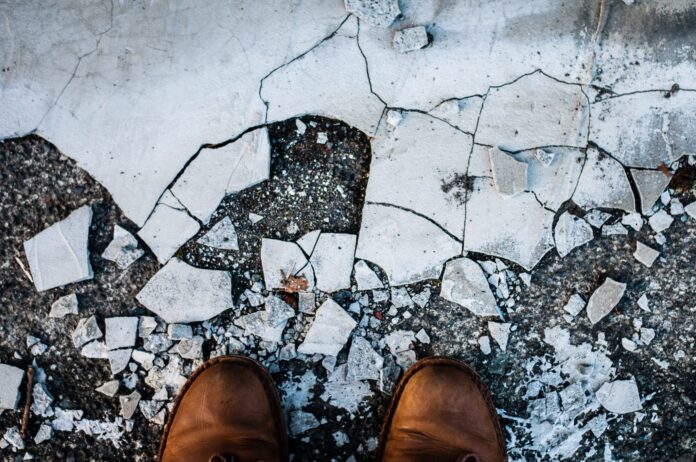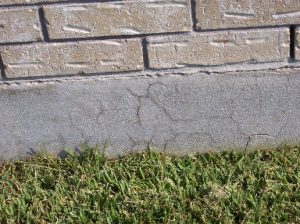There are more solid reasons why concrete has been and continues to be used so widely. Its durable strength and compatibility with many uses make it the ideal construction product. Made-to-order concrete is among the most popular artificial materials globally, earning popularity even among conservationists.
As a ‘Green’ product, concrete’s thermal mass helps make it more desirable and affordable. But, like anything else, it is not 100% stable. It will eventually reflect the conditions of its environment, which could potentially affect your kitchen cabinet structure and your home in general if it is not fixed immediately.
Causes of Cracks in Concrete
A concrete floor is best for a busy, sociable kitchen. Yet, concrete is not only limited to kitchen floors. It can also be used to make kitchen sinks, countertops, and even walls—and it can be done according to your preferences while still looking modern and on-trend.
Here are some of the concrete cracks causes you should be aware of and prevent from the beginning:
- Poor construction methods
- Settlement cracking or soil weathering
- Reinforcement corrosion
- Chemical reaction and thermal stresses
- Presence of heavy equipment
Since concrete is generally used outside, one should anticipate the eventual appearance of cracks or, at least, hairline fractures.
Just as the weather and temperature fluctuate, so will concrete. It contracts and expands depending on the climate it is exposed to. Hot weather usually produces more “shrinkage” cracks. Shrinkage cracks are common, often of hairline stature, caused by water evaporation. They may run through the entire slab.
It’s not necessarily an indication of serious damage, and as stated previously, it is generally commonplace. But the heat causes the mix to dry promptly, requiring more water, making a perfect balance difficult to achieve. Sometimes, cracks may even appear within a day of their creation.
Tips on How to Prevent Cracks in Concrete
You heard them say, “Prevention is better than cure,” which is true. It is better to take preventive measures beforehand than regret later and deal with costly and time-consuming repairs. The same goes for concrete.
Proper planning can prevent potential cracks in concrete or lower the intensity at the onset of construction. Yes, it is possible to curtail crack formation starting at the beginning. Let’s check the steps you can take to avoid concrete cracking.
Assess The Area
Before starting any concrete project, it is important to know the real situation of the area where you will be laying the foundation. Ensure the site is smooth and level, as any shift in the ground’s soil profoundly affects the concrete’s stability.
In addition, make sure you won’t be pouring near trees where the roots may lift up your concrete slabs, resulting in cracking or warping.
Use Quality Concrete Materials
The materials you use affect the outcome of your concrete. Before starting any concrete-related project, make sure you are using top-quality concrete. By using high-quality concrete materials, there’s a lesser chance of potential cracking.
Mix The Proper Amount of Water
Monitor carefully the ratio between water and cement in the mix while strategically including synthetic fiber additives. This will decrease the appearance of cracks. If possible, reduce the water content in the concrete mixture. Avoid a super wet consistency while mixing.
Don’t Forget to Add Reinforcements
Ensure your concrete’s durability and longevity by adding reinforcements which could be steel or fiberglass. This process will add tensile strength to the structure, helping it to resist any vibration and compression forces.
Install Expansion and Control Joints
Since water excess will contribute to cracking potential, it is ideal to facilitate the use of ‘expansion’ and ‘control joints’.
Expansion and control joints are separations made of rubber or metal grooved into the outer surface of the concrete. They help take pressure off a slab. The grooves are purposely incorporated using a tool to etch in the joint while concrete is poured. A control joint allows the concrete to crack freely in predetermined areas.
So, “expansion” cracks are intentionally designed to be controlled by the joints that run the depth of the slab and provide complete separation between sections. Once again, hot weather will contribute to new cracks, and without a joint installed to prevent friction and pressure, you may be looking at one fractured block.
Avoid Extreme Temperatures
When it comes to concrete construction, avoiding extreme temperatures when pouring concrete is important. Install windbreaks to protect the new concrete from potential damage. Use white pigment to cure compounds, reflecting excessive sunlight. Consult a local forecast before starting any concrete project.
Cement structures designed for indoor use tend to fare a little better. Although a modern interior allows for greater temperature control, cracks are inevitable. However, by taking advantage of the indoor climate conditions, installers are more successful in creating a close facsimile of a smooth, flawless slab.
Cure Your Concrete Properly
The concrete curing process requires adequate moisture retention at the right temperature level to prevent cement hydration early after the pour. As concrete takes about 28 days to cure completely, it is important to intervene to allow it to reach its full strength.
As a solution, you can spray water for the first few weeks to ensure moisture remains and does not evaporate immediately. However, you can avoid the tedious process of spraying water by using a curing agent to control the moisture level later. The curing agent is added to the water before combining the concrete.
Protect Your Concrete With Plastic Sheets
You do not want your concrete to lose moisture quickly, as this will cause cracking. Thus, it is best to cover your wet concrete with plastic sheets to slow the drying process.
Use Proper Finishing Techniques
In addition to the above tips, you can prevent concrete cracking using proper concrete finishing techniques such as troweling and flat floating. Vibratory screeds can also be used, however, it can overwork the concrete.
Avoid Heavy Loads on Concrete
Concrete floors can crack when under pressure from heavy loads, especially if it is recurring. Therefore, it is best to avoid placing any overbearing weight on concrete or dropping heavy objects, which can cause a big impact. In addition, large trucks and heavy equipment, such as dumpsters or tree removal machines, can crush the concrete.
What To Do When Concrete Cracks Appear In Your Home
Some factors that cause cracks in concrete are out of our control. So, what do you do when they eventually appear? How do you fix cracks in concrete?
As mentioned earlier, repairing concrete tracks is time-consuming and can be costly. There are many steps you have to take to repair concrete cracks, depending on the types of cracks and your budget. The basic process could include cleaning the concrete and using fillers or sealers to avoid bigger cracks.
Cracks can generally be fixed using concrete patching compounds or crack fillers to create strong bonds and smoothen the surface with a putty knife. Any voids in concrete can be filled with foam, mud jacking, or stone slurry grout to revive the slab support.
Get a Free Design Consultation For Your Kitchen
Cracks in concrete don’t necessarily mean they are unappealing, though. Graphic Artists even use the look as a design choice. When cracks appear, it is wise to determine if they need fixing and pose any threat to a building structure or to people nearby.
Overall, since concrete is durable and adaptable, the drawbacks of cracks are greatly outweighed by the benefits. We can take steps to reduce the cracks, but they are a generally accepted flaw of a much greater machine. For the foreseeable future, at least, concrete’s job security is… concrete.
Get a free professional design consultation and see what you can do with your concrete floor kitchen.












